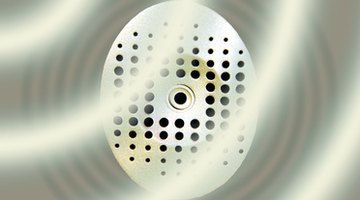How Do Sound Activated Devices Work?
There are many sound-activated devices available on the market, one of the more recognizable and popular ones being The Clapper, which is a light that reacts to the sound. You must have a basic understanding of circuitry to understand how sound-activated devices actually work. Circuitry is the physical method by which electronic signals are communicated and, in essence, make electronic devices "work." Sound-activated devices have what is called a "sound-trigger" circuit.
Microphone

Sound-activated devices all have a microphone, usually a small one. The function of a microphone is to register the presence of sound waves in the immediate surrounding area and then convert the sound wave to an electronic signal. In digital recording, for instance, the microphone sends the electronic signal to a computer so that it can create a digital file.
OP Amp
When the microphone registers a sound, it converts it to an electric impulse and sends that impulse to the Operational Amplifier (OP Amp), which U.S. Motors explains is an amplifier that is designed to receive electricity and transmit it to other elements of the circuit. There are other types of amps, but the OP amp is the most common for more sophisticated circuitry such as that involved in sound-activated devices, according to ECE Lab.
Transistors
The OP amp routes the electrical signal through a series of transistors. A transistor will either conduct (i.e., allow to pass through) or block the electricity, depending upon the type of electrical impulse it receives. Transistors are arranged in device circuits to route electricity from a power source such as a plug in the wall or a battery to the device output, ultimately powering the device. In this case, the impulse sent from the microphone is triggering another circuit to access the power source, usually a battery, that powers the device.
Range Setting
An important element of any sound-activated device is to have a defined range of frequency or volume sensitivity. The Clapper, for instance, has its microphone calibrated to respond to a volume that will only be achieved by a moderately strong clap. More sophisticated devices, such as ones that respond to certain voices, have microphones calibrated to respond to a given range of frequencies so that it might respond to high-pitched voices, but not medium- or low-pitched ones.
Turning Off
The way that a sound-activated device deactivates is through the same mechanism. When the microphone detects a sound within its established range of volume and frequency, it sends an impulse that travels through the opposite transistors and flips the resistors so that the electricity is no longer traveling to the output.
References
Writer Bio
Ray Dallas graduated with majors in journalism and English. While in Florida, he wrote freelance articles for "The Alligator" and was the copy editor and a writer for "Orange & Blue." Since moving to California, Dallas has worked as a script reader and for a talent manager, as well as taking numerous industry odd jobs.
Photo Credits
- sound image by Svetlana Kashkina from Fotolia.com
More Articles



